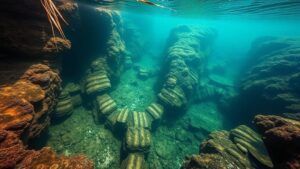Searching for the “Mirror City,” a lost settlement said to lie beneath the shifting sands of the Sahara.
Searching for the Mirror City: The Myth of a Lost Settlement Beneath the Sahara
The quest for the so-called Mirror City represents one of the most intriguing mysteries hidden beneath the vast, ever-shifting sands of the Sahara Desert. This legendary settlement is said to possess an extraordinary architectural layout, characterized by reflections and symmetry that have captivated explorers, historians, and archaeologists for centuries.
Historical Context of the Mirror City
The concept of a lost city in the Sahara is not a modern invention; rather, it has roots in ancient texts and traveler accounts. The earliest references to such settlements can be traced back to the writings of Herodotus in the 5th century BCE, who spoke of cities that had vanished over time due to the encroaching desert. Sahara, which covers approximately 9.2 million square kilometers, is a landscape defined by its extreme climate and dynamic geography, making it a challenging area for both settlement and archeological investigation.
Reports of the Mirror City gained traction in the 20th century, particularly through the writings of explorers like Cyril Aldred and his remembrances of lost cities beneath the sands. He suggested that sophisticated civilizations once thrived where now only dunes exist.
Characteristics of the Mirror City
The name Mirror City evokes the image of a captivating metropolis with reflective surfaces, precise geometric designs, and intricate layouts reminiscent of urban environments like ancient Egypts Thebes or the architectural wonders of the Mesoamerican civilizations. While these descriptions paint an enchanting picture, many aspects of this legendary city remain speculative. Key characteristics attributed to the Mirror City include:
- Symmetrical layouts, potentially including squares and circles
- Buildings allegedly designed to reflect sunlight, creating dazzling visual effects
- Engraved symbols that hint at a forgotten linguistic heritage
Evidence and Attempts to Locate the City
Despite the absence of concrete archeological evidence, the search for the Mirror City has inspired numerous expeditions. In the late 20th and early 21st centuries, technology such as satellite imaging and LIDAR (Light Detection and Ranging) became integral to the search. These tools have unearthed potential sites of interest, prompting further exploration in areas like:
- Southern Algeria, particularly in the Tassili nAjjer region
- Western Egypt, near the Gilf Kebir plateau
- Northern Mali, where ancient trade routes intersected
In 2018, a joint expedition by French archaeologists and local experts resulted in the discovery of unusual earth formations in southern Algeria. While these sites weren’t definitively linked to the Mirror City, the findings raised questions about the existence of ancient human settlement in these previously unexplored regions.
The Significance of Cultural Myths
The legend of the Mirror City encapsulates more than just the allure of discovery; it serves as an important cultural narrative. Myths about lost civilizations often reflect human desires for connection with the past and understanding of our history. The persistence of the Mirror City myth underscores humanitys fascination with what lies beneath the surface of the earth and our collective yearning to solve historical enigmas.
Challenges in the Search
Several challenges complicate the search for the Mirror City, including:
- Extreme climatic conditions that can reach temperatures of 50°C (122°F)
- Political instability in regions of the Sahara, limiting accessibility and safety for researchers
- The vastness of the desert, which encompasses numerous potential sites for exploration
Researchers often must navigate these obstacles while relying on limited historical documentation and the occasional tantalizing clues from ancient texts.
Conclusion: The Endless Quest
The allure of the Mirror City continues to spark imaginations, pointing to the human spirit’s enduring quest for knowledge and discovery. As archaeologists enhance their methodologies and technologies, the hope persists that one day the sands of the Sahara will yield the secrets they guard.
For now, researchers and enthusiasts remain committed to the search, driven by the dream of unearthing not only architectural marvels but also pieces of our shared history. This ongoing exploration is a testament to humanity’s resilience, curiosity, and capacity for storytelling, keeping the legend of the Mirror City alive in our collective consciousness.


